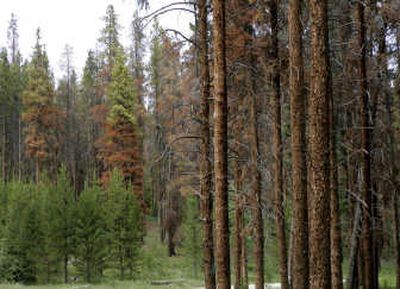Beetles threaten western lodgepoles

Western forests are vulnerable to attack from same beetles that chewed their way through interior British Columbia, infesting an area more than four times the size of Vancouver Island, a University of Idaho professor says.
Jeffrey Hicke’s research concludes that roughly 46 percent, or 7 million acres, of lodgepole pine forest in the Cascades and Rocky Mountains is highly susceptible to the mountain pine beetle. The beetles burrow under the bark, girdling the trees.
“They’re a natural part of the forest, but in recent decades … we think the outbreaks are moving beyond natural cycles,” said Hicke, an assistant professor in UI’s geography department.
Temperatures in the West are rising. As a result, the beetles are killing trees at higher elevations and venturing farther north.
In Colorado, beetle outbreaks have closed campgrounds. So many trees are dead and considered hazardous that the Forest Service can’t cut them quickly enough to keep campsites safely open. In British Columbia, the beetles’ legacy is dead trees spreading over 33 million acres.
Mountain pine beetles thrive in warmer temperatures, and they may also speed up climate change. In reports released this week, scientists said the sheer volume of beetle-killed trees is transforming British Columbia’s forests from carbon sinks to carbon emitters.
Trees scrub the air of carbon dioxide, using the greenhouse gas as a food source, Hicke said.
“Now you have the beetle coming along and killing large swaths of trees. That eliminates the forest that was taking up carbon from the atmosphere,” he said. “And as the dead trees decompose, they’re releasing carbon back into the atmosphere.”
Hicke’s research projected where future beetle outbreaks were most likely to occur. Parts of the Rockies – including central Idaho and southwestern Montana – are hot spots. The Idaho Panhandle, northeastern Washington and parts of the Cascades were less likely to have severe outbreaks, his research concluded. The age, vigor and densities of the lodgepole stands were determining factors.
Healthy lodgepoles thwart beetle attacks by ramping up sap production, which is toxic to the beetles and entombs them.
But when beetle populations are high, the bugs mount synchronized attacks that leave the trees little chance of survival.
The beetles emit pheromones – “come join the party” chemicals that attract other beetles to the same host trees, Hicke said. “When the tree is full of beetles, the pheromone switches to ‘This tree is full. Go somewhere else.’ “
Beetles bore into the trees in late summer and lay their eggs. When the eggs hatch, the larvae feed on the whitish, cambium layer just inside the bark. The trees may still have green needles, but already be dead.
“They cut the tubes that connect the leaves to the roots,” Hicke said. “You have these teeny, teeny beetles killing these huge trees.”
Not every lodgepole in a stand will die, according to Hicke. In the past, high susceptibility has translated into a loss of about one-third of the trees, he said.
Lodgepole pines are versatile, growing in a variety of forest types and elevations. They make up about 12 percent of the Idaho Panhandle National Forests’ trees.
Since 2000, beetle outbreaks have been on the upswing in the upper St. Joe River region, which supports some of the forests’ largest lodgepole stands. Beetles are also attacking patches of lodgepole north of Bonners Ferry and along the Bitterroots straddling the Idaho-Montana border.
The outbreaks aren’t surprising, said Art Zack, a forest ecologist and silviculturist. Many of the forest’s lodgepole pine stands sprang up after the 1910 fires. They’re closing in on the century mark and they’re less healthy, which is a factor for beetle infestations, Zack noted.
Hicke’s work suggests high mortality rates for lodgepole in years to come. Acres of dead trees will affect timber harvests, wildlife habitat and even the aesthetics of the forest, he said. In Colorado, tourists are already encountering hillsides covered with orange-needled pines.
But eventually, the lodgepole will regenerate, Hicke said.
“Mountain pine beetles and the lodgepole have lived together for millions of years,” Zack said. “The beetles are a natural recycling agent.”